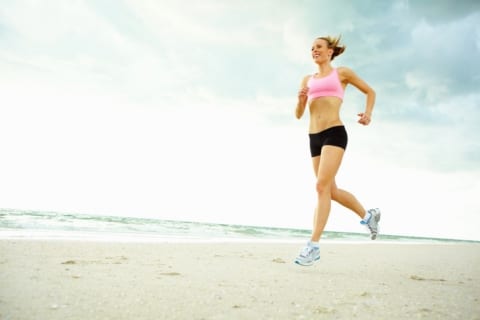How to handle the heat
May 16, 2012

When temperatures rise, outdoor exercise can be a challenge. Here’s a breakdown on staying cool while staying fit.
WHAT TO DO AND WHY
Drink fluids
Staying hydrated is critical to your body’s peak performance because it helps you sweat and helps your circulation system stay efficient, both of which help your natural cooling system. Make sure to:
- Load up on water 30 minutes before exercising
- A normal adult should drink 16-32 ounces of cool fluids for each hour of heavy exercise
- Drink enough to quench your thirst after exercise during recovery
- Avoid alcohol and caffeine, which actually cause you to lose fluid
Replenish nutrients
Heavy sweating depletes the body of essential salts and minerals. So in addition to water, go for a sports drink if you’re working out in extreme heat or if your workout exceeds one hour.
Avoid high temperatures
Exercising before 10 a.m. and after 7 p.m. may be your best bet in Florida; a good rule of thumb is to stay inside when temps rise to 90 degrees plus.
Avoid high humidity
When humidity is high, sweat doesn’t evaporate as easily, which traps body heat; consider postponing your workout or taking it easy if humidity is greater than 60 percent.
Dress properly
Lightweight, light-colored and loose-fitting clothing are best for keeping cool. Never wear rubberized sweat suits or clothing that is impermeable to water, which prevents sweat from evaporating. Wicking fabric designed to pull moisture away from the skin may also be a good option to try.
Use sunscreen
Burns interfere with your ability to cool down and may cause loss of fluids. To play it safe, use broad-spectrum, water-resistant sunscreen with an SPF of 30 or more and reapply every 2 hours.
Acclimatize
If you are not accustomed to working out in the heat, start slowly and pick up the pace gradually. Over one to two weeks, you’ll feel the benefits of a lower body core temperature, a decreased heart rate response and reduced risk for dehydration and electrolyte depletion.
Watch out!
Warning signs of heat exhaustion: heat rash, muscle cramping, nausea and vomiting, high body temperature, weakness and fainting. Without prompt treatment, severe cases can cause organ failure, brain damage and death.
Cool off in the water
Looking for cool ways to stay active during the hot summer? Why not make a splash. One fun water activity—and cardiovascular and core upper body workout—is stand-up paddle boarding, a sport that’s catching on like wildfire across Florida. The ancient Polynesian activity is described as a high-intensity, low-impact “Miracle Workout” (because paddlers appear to be walking on water). And if you’re feeling hot, just jump right in to cool down!
You can also try water aerobics, swimming, snorkeling, diving, surfing, kayaking, water-skiing, wake-boarding or playing at the water park.
